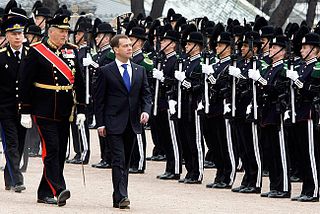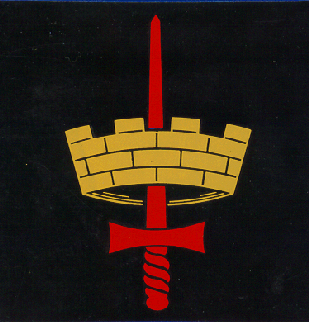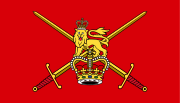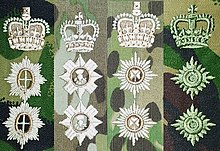The Infantry of the British Army comprises 49 infantry battalions, from 19 regiments. Of these, 33 battalions are part of the Regular army and the remaining 16 a part of the Army Reserve. The British Army's Infantry takes on a variety of roles, including armoured, mechanised, air assault and light.

The Coldstream Guards is the oldest continuously serving regular regiment in the British Army. As part of the Household Division, one of its principal roles is the protection of the monarchy; due to this, it often participates in state ceremonial occasions. The Regiment has consistently provided formations on deployments around the world and has fought in the majority of the major conflicts in which the British Army has been engaged.

The Welsh Guards, part of the Guards Division, is one of the Foot Guards regiments of the British Army. It was founded in 1915 as a single-battalion regiment, during the First World War, by Royal Warrant of George V. Shortly after the regiment's formation, it was deployed to France where it took part in the fighting on the Western Front until the end of the war in November 1918. During the inter-war years, the regiment undertook garrison duties in the United Kingdom, except between 1929 and 1930 when it deployed to Egypt, and late 1939 when it deployed to Gibraltar.

In some militaries, foot guards are senior infantry regiments. Foot guards are commonly responsible for guarding royal families or other state leaders, and they also often perform ceremonial duties accordingly, but at the same time are combat soldiers.
The Scots Guards are a regiment of the British Army. The regiment cherishes its traditions, especially on the parade ground where the scarlet uniform and bearskin have become synonymous with the regiment and the other Guards regiments. The regiment takes part in numerous events, most notably the Beating Retreat, Changing of the Guard, Queen's Birthday Parade, Remembrance Sunday and State Visits. The Guards' regiments ceremonial uniforms differ from each other only slightly, the differentiations being in the tunic and the type of plume on the bearskin, if any, they have. The Scots Guards uniform consists of tunic buttons in threes, the Order of the Thistle on the shoulder badge, the Thistle on the collar badge and no plume on the bearskin.
The hackle is a clipped plume or short spray of coloured feathers that is attached to a military headdress, with different colours being associated with particular regiments.

A bearskin is a tall fur cap derived from mitre caps worn by grenadier units in the 17th and 18th centuries. Initially worn by only grenadiers, its usage was extended to several other military units in the 19th century. The bearskin cap continued to see use in battle during the mid-19th century, although by the 20th century, its use was limited as a headgear reserved for parade dress. In the 21st century, the bearskin cap is retained by select military units as a prominent element of their ceremonial and full dress uniforms.

The Canadian Guards was an infantry regiment of the Canadian Army that served in the same role as the five regiments of foot guards in the British Army. The regiment was formed on 16 October 1953, by Lieutenant-General Guy Simonds, the Chief of the General Staff of the Canadian Army, with the redesignation of four separate battalions:

London District (LONDIST) is the name given by the British Army to the area of operations encompassing the Greater London area. It was established in 1870 as Home District.
The British Army primarily divides its infantry into regiments, which are subdivided into battalions. However, for various reasons, since the end of the Second World War it has also maintained companies that are intended to provide increments and reinforcements.

The Brigade of Guards was an administrative formation of the British Army from 1856 to 1968. It was commanded by the Major-General commanding the Brigade of Guards and was responsible for administering the guards regiments.

The uniforms of the British Army currently exist in twelve categories ranging from ceremonial uniforms to combat dress. Uniforms in the British Army are specific to the regiment to which a soldier belongs. Full dress presents the most differentiation between units, and there are fewer regimental distinctions between ceremonial dress, service dress, barrack dress and combat dress, though a level of regimental distinction runs throughout.
This is the Operation Herrick ground order of battle, which lists any British ground forces that have taken part in the duration of Operation Herrick between 2002 and 2014.
A large regiment is a multi-battalion infantry formation of the British Army. First formed in the 1960s, large regiments are the result of the amalgamation of a number of existing single-battalion regiments, and perpetuate the traditions of each of the predecessor units.

The Grenadier Guards is the most senior infantry regiment of the British Army, being at the top of the Infantry Order of Precedence. It can trace its lineage back to 1656 when Lord Wentworth's Regiment was raised in Bruges to protect the exiled Charles II. In 1665, this regiment was combined with John Russell's Regiment of Guards to form the current regiment, known as the 1st Regiment of Foot Guards. Since then, the regiment has filled both a ceremonial and protective role as well as an operational one. In 1900, the regiment provided a cadre of personnel to form the Irish Guards; while later, in 1915 it also provided the basis of the Welsh Guards upon their formation.

The Guards Division was an infantry division of the British Army that was formed in the Great War in France in 1915 from battalions of the Guards regiments from the Regular Army. The division served on the Western Front for the duration of the First World War. The division's insignia was the "All Seeing Eye".

The London Guards is an administrative formation within the British Army comprising the reserve companies of the Grenadier, Coldstream, Scots and Irish Guards. On formation these companies drew their personnel from the London Regiment and it traces its history back to the formation of that regiment in 1908 when 26 separate Volunteer Force battalions were brought together. The London Guards is not a regiment, the companies wear the uniform, and follow the traditions, of their foot guards regiment.

The Guards and Parachute Division is an administrative unit of the British Army responsible for the training and administration of the regiments of Foot Guards and the Parachute Regiment. The division is responsible for providing two battalions for public duties to London District ; although the guards are most associated with ceremony, they are nevertheless operational infantry battalions, and as such perform all the various roles of infantry.













